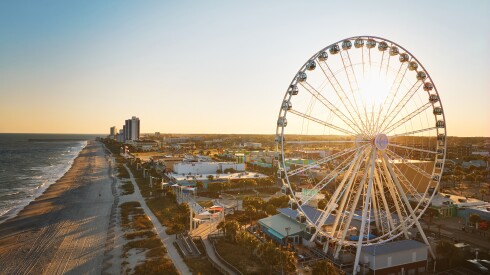This story was originally published on December 11, 2013. We recently dusted it off from the archives and added some new information.
Looking up at the morning sky above the Routeburn Track—one of the great hiking trails in New Zealand, which is to say one of the great hiking trails anywhere—I saw a drab green parrot flapping hard against a light breeze. It was a kea, the only parrot in the world that reaches this sort of mountain country, a place of rock faces, snow fields, and tussock grass far above the dark beech forests in the valleys below. As I watched the chunky, squawking sack of feathers above me, I realized something: Kea flight is hard work. A lot of effort without much thrust, a lot of noise for not much progress.
My 11-year-old son, Angus—he likes to call himself “Kidbot”—missed the whole kea encounter. Instead of looking at the sky or the mountains or anything else in this corner of Mount Aspiring National Park on the southwest edge of the South Island, he was pacing back and forth inside the lodge, bouncing his racquetball and chanting to himself in a near trance. Whether he’s at home in Billings, Montana, or on a mountain trail 8,000 miles away, he likes to bounce and chant for a couple of hours each day. When he really gets rolling, he sounds as if he’s possessed by a 1980s freestyle hip-hop beatboxer who, in turn, is possessed by a big-band scat singer, and they’re both crammed inside one autistic boy.
I entered the lodge, a wilderness oasis with hot showers, private rooms, and professional cooks. It was just uphill from the hut where budget-minded backpackers have to, perish the thought, cook their own meals and sleep in barracks. “Hey, buddy,” I said. “Time to grab your pack and get going.” That’s not a direct quote, though, because I had to cough between a few of the words. Starting my second day in New Zealand, I had been battling a self-diagnosed case of “walking pneumonia” that was building to a full gallop. My appetite and energy had vanished, leaving me with a mild fever, body aches, and deep, deflating coughs. I said to Angus, “You’re killing this hike. We have one day left. Let’s keep it up.” “OK, Dad,” he said in his usual flat, mechanical voice, adding: “Da-da-nun-nun-dun.”
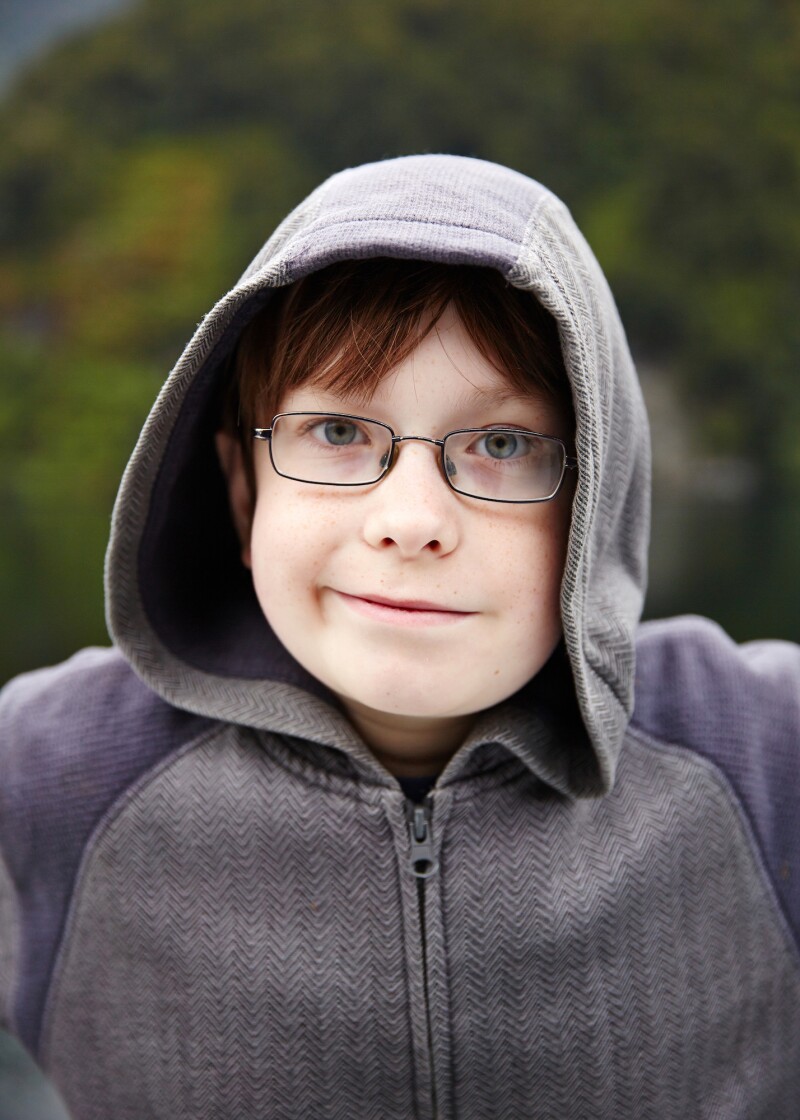
11-year-old Angus also goes by “Kidbot.”
Photo by Sean Fennessy
We didn’t look or sound like a pair of mountain warriors. A middle-aged, gray-haired coughing machine and his loose-limbed, beatboxing Kidbot companion. Angus is a smart kid who struggles with basic concepts such as spelling and multiplication, a screen addict who can spend an afternoon editing cartoons for YouTube but can’t hold eye contact for more than a few seconds or sit still at his school desk, a self-described wimp who had been asked—forced, really—to take an epic hike with his dad. We had already covered 17 miles and now had six left to go. Amazingly, we had reached the lodge before any of the other hikers in our group. Amazing because, in a way, we had to go farther than any of them.
New Zealand and I had some history. In 1985, I spent a year as a high-school foreign-exchange student in Otaki, a small sheep-and-kiwifruit town on the North Island. A year abroad is supposed to “change” a person, but I was, to a close approximation, as nerdy at the end of the year as I had been at the beginning. I was the only boy in my grade who wore long polyester pants instead of shorts for the school uniform, the only exchange student in recent memory who wasn’t athletic enough to play rugby. Or netball. Or even cricket, a sport that mainly requires a lot of standing around. Little kids mocked my accent; kids my age were more amused by my bouncy walk, my skinny, pale form and my complete inability to hold down my beer.
I’m probably most remembered for the day I climbed into a kayak in the school pool, long pants and all. Mr. Hoyle, the PE teacher, had instructed me to tip over so I could practice popping back up. Capsizing a perfectly seaworthy vessel seemed a little counterintuitive to me, but he made it sound easy. I paddled around for about 15 minutes as a crowd gathered to watch. I finally summoned about 75 percent of the courage necessary and tipped over just far enough for my panicky face to stay above water. There I was, the cultural ambassador from Montana, flailing and gasping for air like a leg-trapped muskrat. My reputation never recovered.
Breakthrough or breakdown? We’d know in 23 miles.
But New Zealand did rewire my brain. When I got back home, I had recurring dreams about mountains and green pastures, beaches and rivers. (On bad nights, I dreamt about that pool. And I didn’t always have my long pants.) In my waking hours, I made plans to return to New Zealand to settle some unfinished business, to really experience the country without the stress of trying, and failing, to fit in. I wanted to catch a big New Zealand trout. I wanted to cruise through the famous fjords. And, above all, I vowed to someday tackle one of the South Island’s world-famous hiking trails. The Milford Track. The Hollyford Track. And, of course, the Routeburn, the most mountainous of them all. The images gathered in my head: soaring waterfalls, dense native bush, clear streams, vertical peaks. And me in the middle of it, wide-eyed and winded.
In my vision, I was fit, young, and hiking solo. But now, on the first day of the trek, I found myself rolling up to the Routeburn trailhead in a bus with my son, three guides, and 27 other hikers, all of them already tired of listening to me cough. Hoping to make the journey a little less stressful, I had signed us up with Ultimate Hikes, a company that guides walks on all of the famous South Island tracks. We’d stay in its primo lodges, and we wouldn’t have to pack cooking supplies or any food except snacks and sandwiches for the trail. Most of all, we’d have guides Gina, Rob, and Dickon around to tend to blisters, provide regular doses of encouragement, and make sure we didn’t get lost or left behind. I sized them up at our first meeting in Queenstown and figured that, yes, each was capable of carrying a sobbing 11-year-old a fair distance. Gina especially. If it came to that.
We all milled around at the trailhead, stretching our legs and loosening up after the three-hour ride from Queenstown. It was early March, the last gasps of summer in this part of the world, and a light mist was turning into a sprinkle. The group included travelers from New Zealand, Israel, Australia, England, and the United States. One of the walkers used to live just a few blocks away from my house in Montana. Almost without exception, they were all serious trekkers, the kind of people who could exchange stories about Kilimanjaro or Aconcagua.
Kidbot, who didn’t have a lot of hiking stories but would happily talk about his new Sonic Shuffle video game, even if nobody asked, grabbed his trekking poles, stood for a couple of photos, and started walking down the trail, an Under Armour shirt peeking out from his rain jacket and a stuffed Smurf in his backpack. The great Routeburn experiment had begun. Breakthrough or breakdown? We’d know in 23 miles.

More than 14,000 people a year hike New Zealand’s Routeburn Track.
Photo by Sean Fennessy
For someone about to fulfill a decades-old dream, I was loaded with doubts, and it wasn’t just the pneumonia talking. While some hikers worried about twisted ankles or rain squalls, I had a vision of a crying kid curled up in the middle of the trail, refusing to walk another step. When Kidbot is done with something, he’s done. I could just hear him: “Why are we doing this? You don’t care about people. You’re just putting my feelings in the trash.” I’d heard it before.
But the possible upside was huge. Like other autistic kids, my son spends a lot of time locked in his own head. Maybe a big-time hike would grab his attention and alert his mind to the possibilities beyond Sega, YouTube, and the latest episodes of My Little Pony. I wanted to show him something unforgettable, something stunning. Something like New Zealand, the very place that opened my own eyes to the world many years ago.
The group spread out quickly. Kidbot and I fell toward the back, with Rob the guide and a few other walkers not far behind. The trail gradually climbed through a mossy forest of silver beech trees, a largely untouched remnant of primordial New Zealand. Gnarled branches and tiny leaves scattered the dim light. About a half hour in, the sun started breaking through the canopy, adding sparkle to the dripping moss. It was only about 50 degrees out, but fever sweat swamped my shirt, and my legs felt like pieces of statuary. Kidbot steamed ahead, his trekking poles pounding out a steady rhythm. “Are you doing OK, buddy?” I asked. “I’m doing great,” he said. “I mean, look at all this beauty.” I had to stop. As a rule, Kidbot doesn’t notice beauty, let alone talk about it. I wondered—was he appreciating the scenery, or was he reading from some sort of dad-pleasing script in his head? From behind, I could see him swiveling his head, taking in the view.
We were so high above the river, trees, and meadows that walking almost felt like flight.
As we walked, we could hear the chimes of bellbirds and the high-pitched call of a rifleman—a fluttery bird about the size of a Ping-Pong ball—but the forest was largely silent. This place, like the rest of New Zealand, was ruled by birds until mammals started arriving about 1,000 years ago. The kiwis and keas and other native birds didn’t know how to deal with hairy creatures equipped with teeth. Because of these intruders, many New Zealand forests are now unnaturally quiet. But there’s hope. We passed box-shaped traps along the trail, part of a widespread effort by the Department of Conservation and Air New Zealand to clear the forest of predators and restore native birds—valuable creatures that are too clumsy and naive to get by on their own.
Kidbot was beatboxing to himself when we reached a series of clearings six miles down the trail. But happy noises don’t always last, and a soft whine crept in. “Dad, my back is tired,” he said. OK, I thought, here comes the drama. But instead of melting down, he simply took off his pack, set it on the ground, and kept on walking. I picked up the pack and carried it in one hand. It held his Smurf, a change of clothes, and not much else. He might have felt a little lighter, but he was essentially carrying the same load.
“Hey, Dad,” he said. “Guess what song I’m tapping out.” As he walked, the metal poles hit the rocks like drumsticks. I was thinking “We Will Rock You” by Queen. But I’m rarely right about such things. “It’s the theme song for Sonic Adventure 2,” he said.
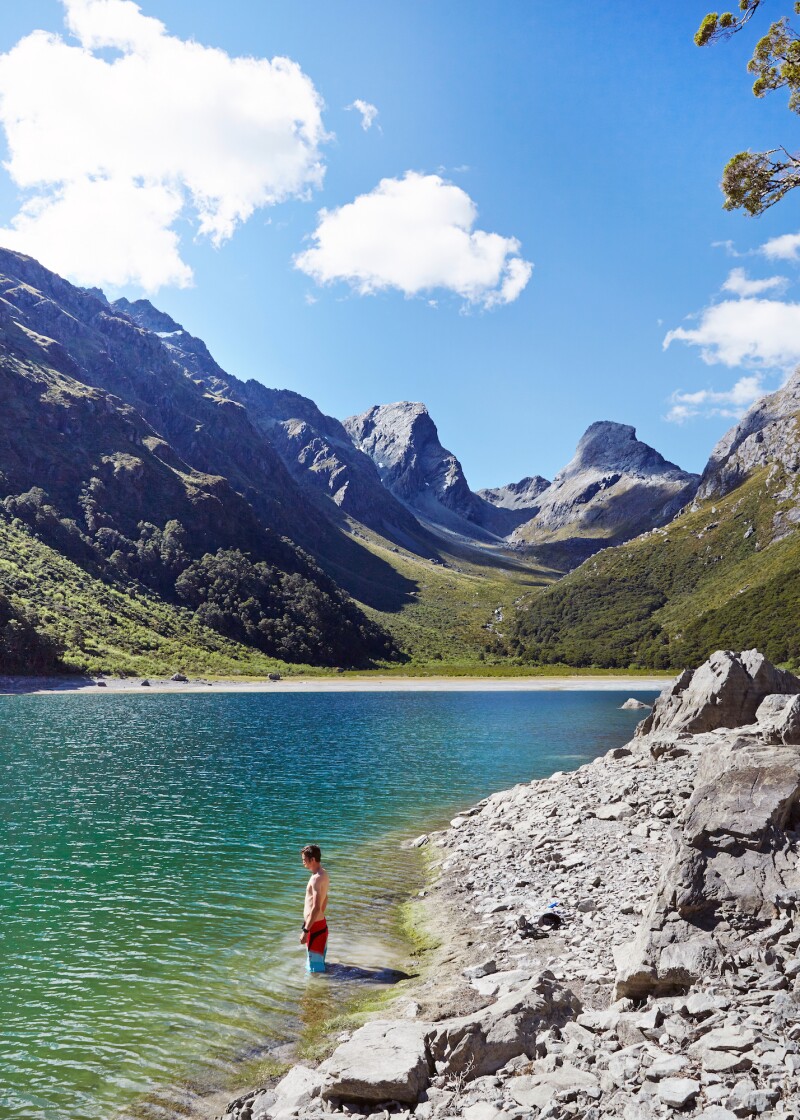
The Routeburn Track weaves through meadows, reflective tarns, and alpine lakes, linking Mount Aspiring National Park with Fiordland National Park.
Photo by Sean Fennessy
After a mile or so of slow downhill over a bunch of big staircase rocks—Kidbot concentrated on every step, just as he does on real stairs at home—we reached the Lake Mackenzie Lodge, our stopping point for the night. The main building has a dining area, a bar stocked with New Zealand beers and wines, huge windows looking out at the clouds, and a mingling area with chairs and couches for tired hikers. A covered outdoor walkway led to our rooms and, more important, the showers. I quickly hopped in and breathed steam into my aching lungs while Kidbot bounced his ball. We had walked more than eight miles in less than six hours. And he was still in a bouncing mood.
Maybe I shouldn’t have been surprised. Kidbot had already shown that he had brought something extra to New Zealand. Or maybe he had left something behind. Days before the hike, he displayed real perseverance on the banks of the Broken River in the mountains west of Christchurch.
It was Lord of the Rings country, where bare mountains shoot up above winding valleys and vast sheep pastures. As I stood knee-deep in the glass-clear water, stalking rainbow trout with the help of our fishing guide Nigel Birt, Kidbot resisted the urge to walk to the car and call it a day. He fooled around with his racquetball, took some pictures, talked to himself about the Sega Dreamcast, and occasionally commented about the local bumblebees. “Ahhhh! Stingers!” He held on for five heroic hours, enough time for me to catch the fish I had hoped for, a four-pound-plus rainbow. In one photo, Kidbot is holding the net and flashing a genuine smile—something rarely captured on camera.
He stood there, leaning on his trekking poles as if he’d been conquering mountains his whole life.
When morning broke on our second day on the Routeburn, we were suddenly surrounded by mountains that had been lost in the clouds the day before. Patches of snow above us glowed in the sunshine, and the day felt full of promise. After a breakfast of cold cereal and hot scrambled eggs, Kidbot and I stood in front of the lodge, thinking about where we had been and where we still had to go. “Dad, look at the sky over there,” Kidbot said, pointing at a low fog bank. “Yeah?” I said. “It looks like a renderization error. Like there’s a blank spot that the computer forgot to fill in.” “Huh?” I said.
Kidbot put on his pack, apparently having forgotten that I could carry it for him, and we started a slow, zigzag climb through the beech forest above blue-green Lake Mackenzie. The trees thinned as we moved higher, leaving space for grass, ferns, and New Zealand edelweiss. After two miles, we reached Ocean Peak Corner, a rocky ledge where the trail sharply turns to the other side of the mountain, opening up new views of the Darran Mountains and the Hollyford Valley. Kidbot and I sat down for a water break with Gina, our guide that day. Gina—an outdoor education specialist who plays rugby and runs marathons in her spare time—told us that on a clear day you could see the Tasman Sea from here. I felt I could already see plenty. Kidbot got up and started walking without his pack. Gina, who has run the Routeburn in less than five hours, had that thing strapped to her back in no time.
For the next three miles, we traversed a mountainside garden of grass, rocks, and native shrubs. Ragged bits of clouds stuck to the slopes both above and below us, but the air was calm and comfortable. Kidbot moved with the extra spring of someone no longer carrying a pack. As we walked, I stared down into the Hollyford Valley on our left. We were so high above the river, trees, and meadows that walking almost felt like flight. Slow, deliberate flight.
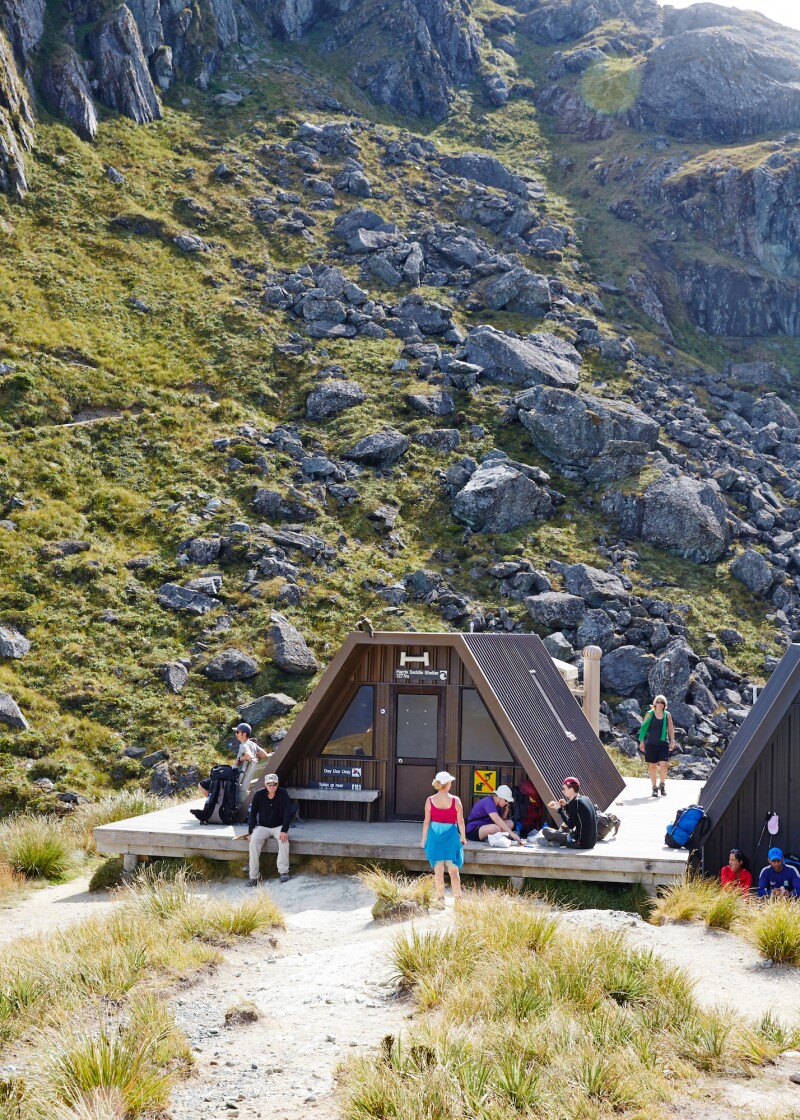
After a long day of trekking, hikers enjoy a rest at the trailside Harris Saddle warming huts.
Photo by Sean Fennessy
We stopped at a tumbling stream that was roughly the color of air. I dipped my water bottle in and took a long, cold gulp. For a moment, I almost felt healthy. Kidbot sensed the moment too. “Dad, I’m really dominating this,” he said. “You were worried, and I took those worries and sent them back in your face.” He stood there, leaning on his trekking poles like he’d been conquering mountains his whole life. I knew then that he was going to sail to the finish line. There would be no tears or tantrums. And if anyone would need an alpine rescue, it would be me. “You’re a superstar,” I replied. “You’re the one holding this whole thing together.”
It wasn’t far to the Harris Saddle, a flat spot with two small shelters as rest stops, one for members of the Ultimate Hikes group and one for everyone else. Ours had boiling kettles and the strong scent of tea. I opted for a cup of hot miso soup while Kidbot had some cocoa. Almost all the hikers in our group had left their packs behind for an optional one-mile hike to Conical Hill, a rocky promontory with especially lofty views. But an extra climb was never an option for Kidbot and Captain Pneumonia, so, after our drinks, we just continued down the trail. In this way, we found ourselves in an improbable position: the front of the pack. We were true trailblazers, the ultimate hikers of Ultimate Hikes, although the steady stream of people traveling the track from the other direction didn’t seem too impressed.
We reached a section of trail carved from a cliff above Lake Harris, an alpine lake fringed with weather-beaten grass—the type of place that looks cold and windy even on a nice day. It could have been the scene for a mountaineering catalog, though the photographer would probably insist on different models. Kidbot handed me his poles and asked for the racquetball buried in my backpack. The trail wasn’t smooth enough for serious bouncing, so he gently tossed the ball in the air and talked to himself as he walked. I’m sure the group of hikers coming the other way wondered about him. Lots of people wonder about him. But what I saw was a happy kid moving down the trail.

Located along the Routeburn Track, Lake Mackenzie Lodge comes complete with a restaurant, bar, and—best of all—hot showers.
Photo by Sean Fennessy
The next morning—after I had my moment with the kea—we hit the trail for the last six miles of the track, a steady downhill from the high country to a forest of red beech trees along the Routeburn River. We crossed several swinging bridges that swayed over deep ravines. My stomach tightened with each step, but Kidbot didn’t even slow down. After a few miles, we reached Forge Flat, where the river flows through deep pools called “swimming holes,” though they’re far too cold for most humans. Everyone else in our group was already there, lazing in the sun.
Kidbot stopped long enough to toss a few rocks in the water before dashing back to the trail, once again leaving his backpack and poles behind. Dickon, one of our guides, stayed with him, which was a good thing, because it took me a half hour to catch up. As I worked to close the gap, I started mentally composing the email I would send to Kidbot’s mom in Montana. She had been wildly supportive of us and this whole trip, but she had her worries. We had been out of contact for three days, enough time for her to envision every possible disaster that had ever crossed my mind, with a few extra thrown in. She never would have guessed that, in the end, I would be the one struggling to keep up.
I reached Kidbot and Dickon a mile from the trail’s end. The bellbirds rang out as the sun lit up the forest. I wanted to stop and listen, but Kidbot wasn’t about to turn off his motor. The trail practically flew by until we reached the final bridge and the sign marking the finish of the track. We were the first in our group to arrive. “We did it,” I said. “I’m super proud.” “Yep,” he said. “Can I bounce my ball?” When we got back to Queenstown, I kept my email short. “We crushed the Routeburn. Angus cloaked himself in glory in every possible way. More details and pics soon. Best walk ever. Cruise on Doubtful Sound tomorrow. Love, Chris and Kidbot.”
Like many other hikers, we decided to follow up our walk with an overnight cruise in Fiordland National Park—the perfect place for reflection. Standing on the deck of the Fiordland Navigator, Kidbot and I marveled at the tree-covered slopes shooting straight up from the water. “Those mountains are like icebergs,” Kidbot said. “It’s like they’re floating.” He paused thoughtfully. “Did you know that Sonic the Hedgehog was Sega’s response to Nintendo’s Mario?”
I didn’t know that. But standing there on the deck, I knew for certain that our New Zealand adventure hadn’t radically opened Kidbot’s mind. He would still have the same quirks and obsessions. But maybe his wasn’t the mind that needed opening. My son was stronger than I realized. He could handle more than I thought, and he could go farther than I hoped. He’ll always stand out, but a Kidbot in this world isn’t any stranger than a parrot in the mountains. He may have to flap harder than most, but he’ll find his way. And I’ll be watching.
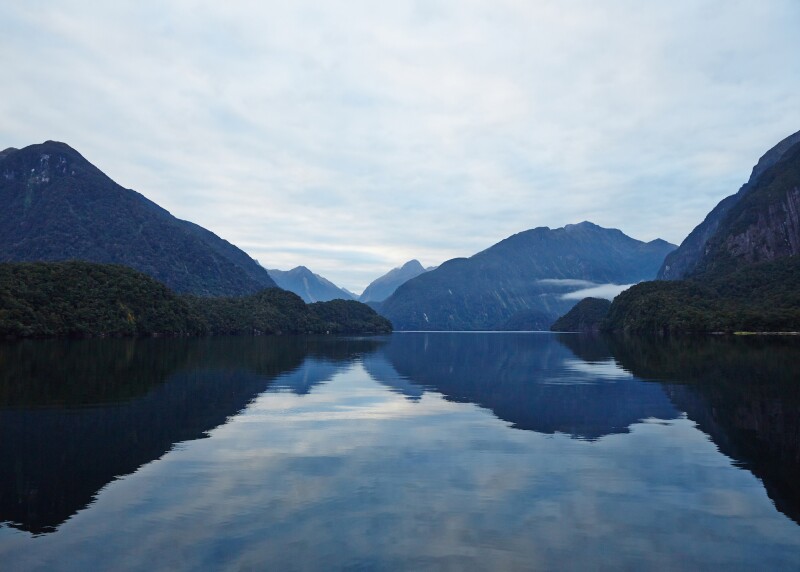
An early morning view of Doubtful Sound
Photo by Sean Fennessy
Classic Family-Friendly Treks
You hike, guides carry the gear—maybe even your kids—and set up camp for you. These outfitters are experienced in leading multigenerational hikes that keep the whole family happy.
Ultimate Hikes
This New Zealand company guides multiday walks on all of the South Island’s famous tracks, including Milford, Routeburn, and Greenstone.
Bredeson Outdoor Adventures
Spend eight days in the Alps, hiking four to six hours a day, as you make your way from the peaks of the Austrian Tyrol to the fairy-tale castles of Bavaria.
Country Walkers
Vermont-based Country Walkers arranges walks worldwide tailored to guests’ interests, from nature to food and history. Follow an expert guide to Icelandic volcanoes, Costa Rican rainforests, and the wild lakes of northwest England.
Enigma Peru
Spend three nights along the Inca Trail on the way to Machu Picchu. Porters teach kids about Incan history and even sometimes carry them when they get tired.
Above and Beyond Alaska
Hike from Juneau to Mendenhall Glacier, where you’ll explore blue ice caves. Any kid who can fit into crampons (usually age 8 or older) can join the adventure.



